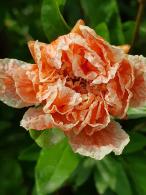Get Additional 5% Off 1st Order
Asimina Triloba Paw Paw Tree
1. Add items to basket
2. Go to the basket
3. Enter your postcode in Delivery Price Check
Pot size: 20 Litres
Plant ID: 9179 2
PRE-ORDER
Pay to pre-order this plant for delivery estimated by 30.09.2025
Asimina Triloba commonly called the Pawpaw Tree, is an understory deciduous tree. Unlike other members of the Annonaceae family, the Asimina triloba is cold hardy so it will grow in the UK. Throughout history, the fruit of the Pawpaw has been used as a food staple. The tree’s origins can be traced back to the Southeastern United States. It was one of the first American plants that was ever introduced by Peter Collinson in 1736.
Asimina Triloba produces large, ovate leaves that measure 20 centimeters in length. During the months of May and June, unusual eye-catching purple flowers emerge that have a pungent aroma. Unlike other flowers that depend on bees for pollination, the flowers of the Pawpaw rely on flies. The flowers also attract butterflies. Following flowering, large edible fruits appear. The fruit of the Pawpaw Tree are not normally found in food markets because the fruit has a short shelf life. During the autumn months, the foliage turns yellow and orange.
Height and Spread of Asimina Triloba
The Pawpaw Tree grows to a height of 3 to 4 metres with a similar spread.
How Hardy is Asimina Triloba
The Pawpaw Tree is hardy in UK zones 6 meaning it can withstand temperatures down to -15 C.
How to Use Asimina Triloba
This tree’s unusual appearance will draw visual interest from onlookers. Plant it in a location where it can be admired. It makes an excellent specimen tree.
How to Care for Asimina Triloba
Plant this fruit tree in full sun or partial shade. It will develop a larger crop of fruit when placed in full sun. It grows well in all soil types and can withstand wet roots for a short period of time. As the tree grows, it frequently develops suckers around its base which should be removed to maintain the tree’s appearance.
Asimina Triloba is a rare and unusual tree that provides an exotic touch to any landscape. Plant it in a location where you can enjoy its unique purple flowers and abundant fruit production.











